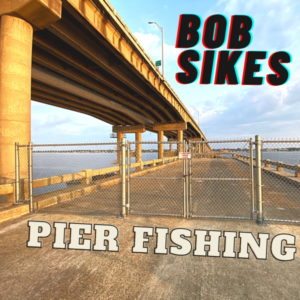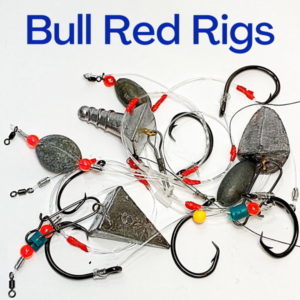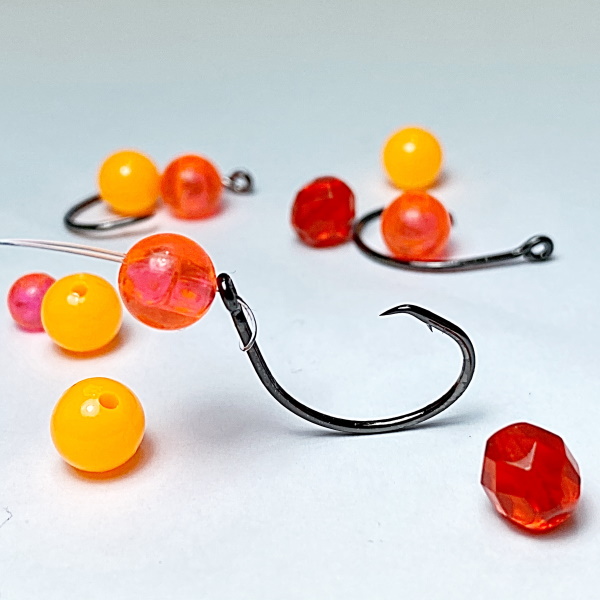
The purpose of using beads on pompano rigs is to add fish attracting color to your presentation. Pompano are sight feeders that rely heavily on their eyes when hunting food. Combine that with the fact that they feed on colorful things, such as coquina clams, and you have a recipe for colored beads to attract more fish.
Besides beads, there are several other ways to add color to your bait. Floats, colored hooks, colored sinkers and Fishbites are all good options commonly used to grab a pompano’s attention.
Let’s find out more about using beads and other options to help attract this visually oriented fish.
Why Use Beads On Pompano Rigs
As mentioned above, pompano are very reliant upon their sight for feeding. This is reflected in the large size of their eyes in relation to their body, as shown below.
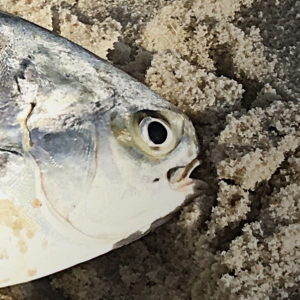
Because they are sight feeders, visual attractants seem to work really well on this species, particularly when you use colors that “match the hatch”. Matching the hatch simply means that you should use colors that closely resemble food items that a pompano is predominantly feeding on, in the area you are fishing.
It’s a good idea to try different colors on your pompano rigs until you hone in on a pattern. Some days, it doesn’t make a difference what color you use.
Best Colors For Pompano Rigs
Below are the 8 best colors for pompano beads, with orange and red being the most commonly used.
- Orange
- Red
- Light Purple
- Yellow
- Pink
- Light Green
- Brown
- White
- Blue
The best colors are those that most closely resemble the coloration of the prey that they are currently pursuing. Much of the time that’s going to be the sand flea, aka mole crab. However, it isn’t the actual color of these sand fleas that you’re usually trying to mimic, but rather the bright orange, or reddish colored egg sacks sometimes found on their undersides. The pompano fishing legend, Larry Finch, refers to these egg sacs as pompano candy. Pompano seem to be very attracted to sand crabs full of these orange eggs, and are thus drawn to orange and red beads.
Headed to the beach this weekend? You might spot the Pacific sand crab (West Coast) or its relative the Atlantic sand crab (East Coast). These critters migrate with the tides. The orange you see in this photo is an egg mass—a female can produce up to 45,000 eggs! [📸: I. Taylar] pic.twitter.com/83dUAf4oEz
— American Museum of Natural History (@AMNH) July 20, 2019
Besides matching the color of a sand flea’s eggs, there are also other prey items that you can attempt to mimic. The most notable of which is the coquina clam, or “donax” (Donax variabili). Pompano love to feast on these little clams.
Coquina clams are impressive things that sometimes seem to take over a stretch of beach. The colors vary greatly, from white to purple to yellow and so on, so you should attempt to use your beads to closely mimic the predominant color found on the stretch of beach you’re fishing. If there isn’t a predominant color, you are free to experiment with colors from the list above, to see if the pompano have a preference that day.
Coquina clams are a critical food source for fish, crabs, and shorebirds. They are also considered an indicator species for beach habitats that can alert biologists to ecological issues. #NatureFact #fwff 📷:@MyFWC pic.twitter.com/exg8xug9jJ
— Fish & Wildlife FL (@wildlife_fl) July 29, 2020
Best Types Of Beads
I suppose everyone has their own personal taste, but I typically prefer 8mm plastic beads that are translucent and prismatic, as opposed to opaque and smooth.
My thinking goes something like this. Clearer water is better when fishing for pompano, that’s a fact. From my knowledge of bass fishing in clear water, you want your bait visible, yet subtle and natural looking at the same time. With a clear prismatic bead, I feel like the bead will blend into it’s surroundings better, and look more natural. At the same time, you’ll still get the coloration in the water, which is what you’re going for.
8mm is a good all around bead size, and is generally what is used for commercially available pre-tied rigs. Anywhere from 6 to 10mm is just fine.
Plastic beads are better than glass because glass can crack and abrade your fishing line. You can also crush plastic beads with pliers in order to remove them from your rigs.
I feel that prismatic beads reflect more light than smooth beads, and possibly attract more fish. So, that’s what I prefer to use most of the time.
Tip: Don’t buy beads that have the big hole through the center. Instead get the ones that have the smaller hole that doubled up fishing line will fit through. It will be obvious which ones have the fatter hole.
Where To Buy Beads
“Fishing beads” can be purchased online at places like Amazon, and other sporting goods retailers. However, you’ll pay less per bead by buying bulk “plastic beads” from craft stores or places like Walmart. Michaels, for example, sells a box of 600 round 10mm beads in 12 bright fish catching colors for $16. In contrast, you can pay upwards of $5 for just 20 beads on Amazon if you aren’t careful. That’s not to say Amazon is a bad place to buy fishing beads. Just be careful which one’s you choose.
Another seemingly reputable place to purchase fishing rig supplies online, such as floats and beads, is lurepartsonline.com
Tip: Buy beads in bulk from craft stores for more choices and better pricing.
How To Add Beads To Pompano Rigs

My preferred pompano rig is a 2 hook dropper loop rig. I don’t like 3 hook rigs because it seems like you just end up wasting bait with them. There are many videos online that will show you how to tie a 2 hook pompano rig. They are very easy to tie, and consists of two loops coming off a main line that ends in a swivel at one end, and an attachment point for a sinker at the other.
The beauty of a dropper loop design is that you can easily remove hooks and beads without retying. This allows you to quickly replace your hardware with different colored beads or fresh hooks as desired. If you do end up using some other type of rig, you can crush plastic beads with pliers to remove them if needed.
You can use 1 bead, 2 beads, or a bead in combination with a float, to add the colors to your rig. No matter the combination, my preference is to add them by simply sliding them over dropper loops and then looping on a small circle hook, as shown in the image above.
Tip: Use a toothpick to pin your beads and floats to the hook in order to keep things where they’re meant to be. This helps keeps your bait from tangling with your main line and off the bottom away from crabs.
Other Ways To Add Color
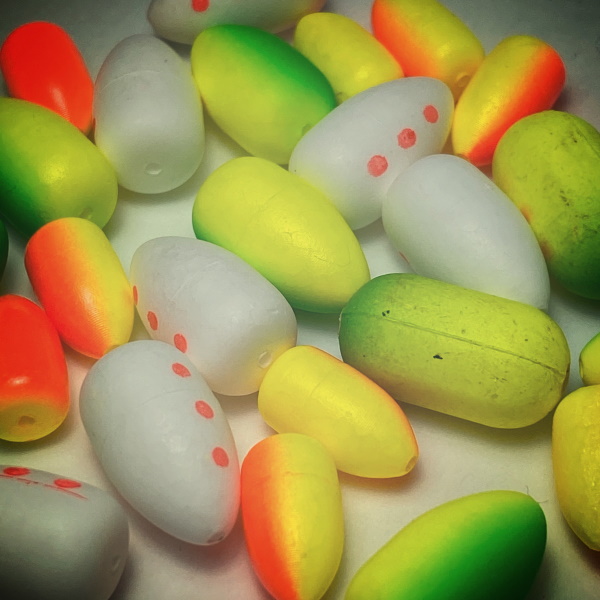
Besides beads, there are several other ways to add color to your pompano rigs. I won’t discuss those in detail here, but we’ll briefly describe each of them below.
- Floats
- Colored Hooks
- Colored Weights
- Fishbites In Various Colors
Floats are the 2nd most popular addition to pompano rigs, besides beads. The extra advantage of floats is that, in addition to adding color, they help keep your baits suspended off the bottom, and away from your main line. This can sometimes aid in keeping your baits away from crabs, and to also help entice the right kinds of fish to hit your offerings. It should be noted that beads don’t usually float, certainly they don’t provide enough buoyancy to float a bait. So, a float can sometimes be a helpful addition to beads.
A recent trend is to use hooks that have been painted on the hook eye end. Gamakatsu makes fluorescent hooks in various colors, or you can try to make your own using powder paint.
Some people even paint, or Plasti Dip, their sinkers in bright colors, in hopes of attracting more pompano to their rigs.
Besides floats and beads, I think the 3rd best option is actually to use small bits of Fishbites, in addition to your primary bait, to add color to your setup. By using Fishbites, you not only add color, but scent as well. Fishbites are available in up to 8 different color combinations, depending on which type you buy.
Conclusion
Even today, with other colorful options on the market, it’s hard to beat the good old fashion plastic bead. It’s still one of the best, and cheapest ways to accurately match the hatch, in order to bring more pompano to the sand or boat.
Happy Fishing
Augustus Clay
For the most complete guide to catching pompano on the internet, check out my article about that here – How To Catch Pompano From The Surf


